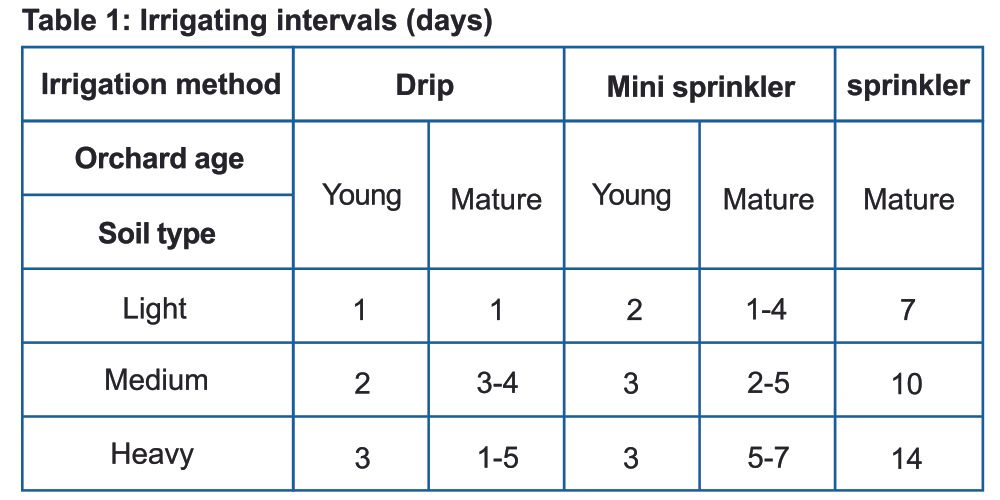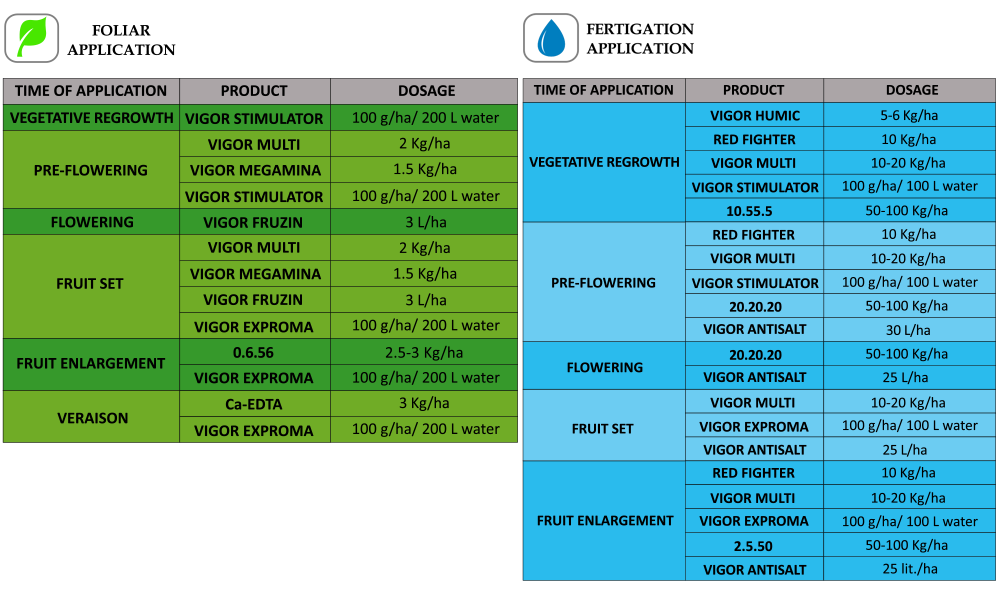Watering and Fertilization Plans
1651401595058.jpg)
Irrigation Management for Stone Fruit
Water supply and delivery
The availability of water for irrigation is essential for stonefruit production. Supply must be reliable and typical water sources include rivers, channels, ground water, and farm dams. Strategic irrigation management offers growers the ability to maintain yield and fruit quality under water limited conditions (e.g. low irrigation allocation seasons).
Water application
Modern water application methods include drip and micro-sprinkler irrigation. Drip irrigation is considered the most water efficient application method as less water is evaporated from the surface wetted area of the soil to the atmosphere (known as soil evaporation). An irrigation designer is the best option to determine irrigation system design and infrastructure (e.g. pump, filter, control station, submains, emitter rate) requirements.
Scheduling irrigation requires decisions on when and how much to irrigate. Scheduling water application to crop needs is critical to manage irrigation efficiently and achieve high production outcomes. Crop water requirement describes the total amount of water supplied to match maximum transpiration of a crop. Water supply to crops is predominantly derived from irrigation inputs and supplemented from soil storage (rootzone) via rainfall.
For stonefruit crops, approximately 7 megalitres/ha of irrigation is required each season. However, more irrigation is required for long-season cultivars, large canopy sizes and drier climates. Typically, where water supply is ‘on demand’ (i.e. available 24/7), irrigation pumps are run overnight due to the lower cost of power. Depending on farm layout and irrigation system design, crop maturity and weather conditions, orchard blocks are irrigated on a 1–3 day irrigation cycle determined by factors like residual stored soil water (e.g. recent rainfall) and crop growth stage.
Over- or under irrigation of crops can lead to fruit quality problems, poor yields and crop loss. However, during a growing season, the stages of fruit development (cell division, pit hardening, cell expansion) and vegetative growth have different sensitivities to water stress.
Irrigation strategies linked to fruit growth and development
Deficit irrigation can offer water savings and production benefits. In stonefruit, fruit growth and development follow a double-sigmoidal pattern. Fruit growth are divided into three key stages:
- Stage I: cell division (rapid fruit growth),
- Stage II: pit hardening (slow fruit growth, maximum vegetative growth) and,
- Stage III: cell expansion (rapid fruit growth)
When these different stages occur during the season varies with cultivar. The best approach to determine these growth stages is to monitor fruit size on a weekly basis by measurements of fruit diameter from shuck fall to harvest. The onset of stone pit hardening can be easily monitored by destructive measurements using a knife to detect thickening and lignification of the fruit endocarp.
Regulated Deficit Irrigation (RDI), can provide control on the level of vegetative (shoot) growth without negative effects of water stress on fruit yield or fruit size. RDI typically involves reduced irrigation inputs during stage II of fruit growth (commencement of stone pit hardening), where fruit growth occurs at a slow rate and vegetative growth is at a maximum. Water savings of approximately 30% are achievable under RDI depending on cultivar (e.g. early v. late maturity). Figure 1 outlines fruit growth during each fruit growth stage and recommended irrigation strategy to maintain yield and fruit quality using RDI.
Recent research conducted by Agriculture Victoria at Tatura has shown fruit quality in nectarine is impacted by deficit irrigation management depending on fruit growth stage. Findings from project SF17006 has shown that moderate deficit irrigation (40% of crop water requirements) confirmed earlier RDI studies whereby there is no effect on yield and fruit size when deficit irrigation is applied from the commencement of pit hardening (Stage II of fruit growth). The new research further demonstrated that moderate deficit irrigation (Stage II at 40% of crop water requirements) maintained key fruit quality attributes (sweetness, maturity, firmness, red skin colour). However, deficit irrigation below the recommend level of 30% during Stage II, and/or during Stage I and Stage III periods of fruit growth resulted in reduced fruit size and low yield.
Deficit irrigation can also be applied during the post-harvest period. Excessive irrigation especially after harvest, can result in considerable shoot growth and should be kept in check to maintain fruitfulness and even cropping within the canopy. Irrigation during the post-harvest period at levels to replace 30% of orchard water use is recommended.

Fertilization Plan






